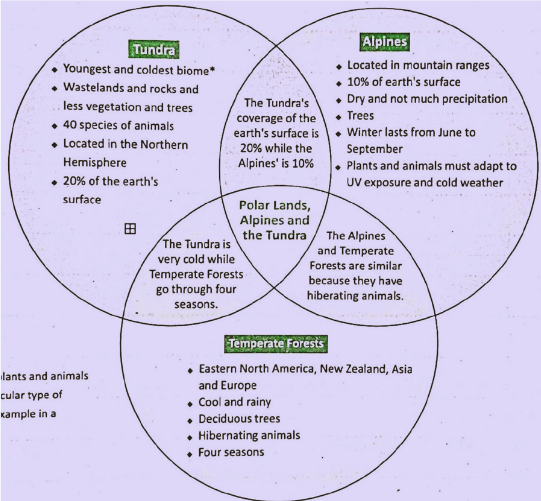Home Assignment: 17 | Class 10 BBC Compacta Solutions PDF Download
Writing (Analytical Paragraph)
Q: The Venn diagram below shows three different types of forests. Study the information given in the diagram and then summarise it in the form of an analytical paragraph. Make comparisons and draw conclusions, wherever appropriate.

"biome: (noun) the characteristic plants and animals that exist in a particular type of environment, for example in a forest or desert"
Ans: The Venn diagram delineates characteristics and overlaps among three forest biomes: Tundra, Alpine, and Temperate Forests. The Tundra is characterized as the youngest and coldest biome, featuring vast wastelands with minimal vegetation and about 40 animal species, covering 20% of the Earth's surface in the Northern Hemisphere. Conversely, the Alpine biome is noted for its mountainous location, sparse precipitation, and a relatively small coverage of 10% of the Earth's surface. Both biomes share harsh conditions necessitating specialized adaptations in flora and fauna, including resilience to UV exposure and cold weather.
Temperate forests, found in regions including Eastern North America, New Zealand, Asia, and Europe, exhibit a cool and rainy climate with deciduous trees and hibernating animals, experiencing all four seasons. Interestingly, while Tundra and Alpine biomes are both cold, the Tundra does not experience the four distinct seasons present in Temperate Forests.
The intersection between Tundra and Alpine indicates a shared cold climate, while the overlap between Alpine and Temperate Forests suggests similarities in tree species and animal behaviors, such as hibernation. This implies a gradient of ecological traits ranging from the extreme conditions of the Tundra to the more varied and milder climate of the Temperate Forests, with Alpine biomes acting as an intermediate environment sharing attributes with both. The diagram underscores the adaptive strategies life must employ in varying climates and the continuous spectrum of environmental conditions across different biomes.

|
Explore Courses for Class 10 exam
|

|

















